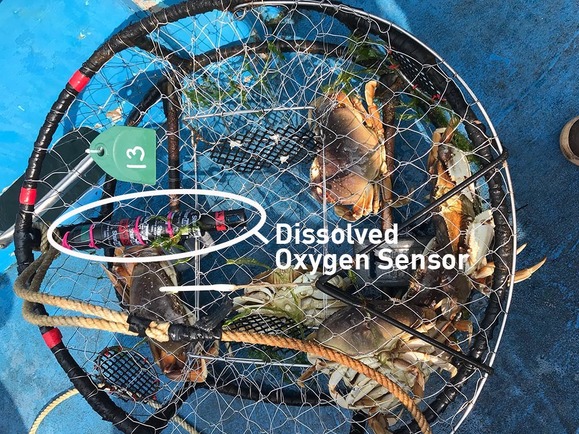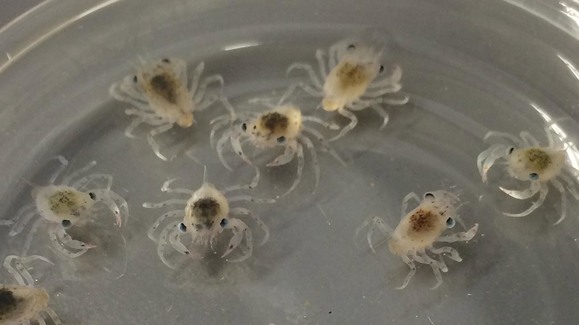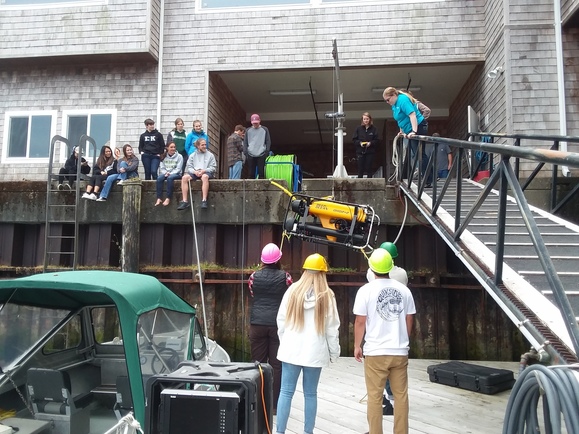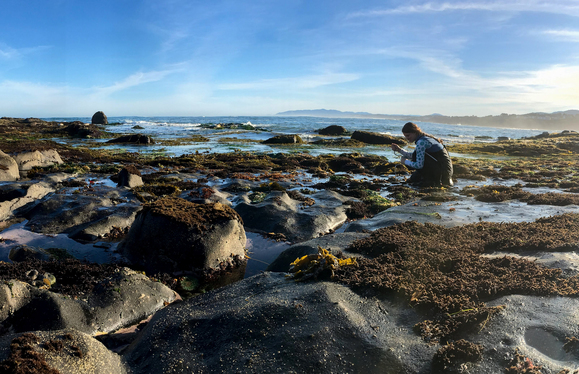 Dissolved oxygen sensors were deployed near Cape Perpetua Marine Reserve and off of Newport in response to dead fish and crab that washed up on beaches along the Oregon Coast last month.
In mid-August, dead fish and crab washed up on beaches along the Oregon Coast. In order to determine if low dissolved oxygen was a factor, two oceanographic sensors that measured oxygen levels in the water were deployed near Newport and the Cape Perpetua Marine Reserve by the ODFW Marine Reserves Program.
This rapid response effort was done in collaboration with Oregon State University scientists, the ODFW Commercial Crab Program and the ODFW Ocean Acidification and Hypoxia Program. The data collected from those sensors are currently being processed by researchers from OSU and ODFW.
Many Faces of Science: Jim Burke of the Oregon Coast Aquarium

Marine reserves science crosscuts a variety of backgrounds – from oceanographers, to fishermen to community leaders – there are many people who support the research that occurs in Oregon’s Marine Reserves. The Oregon Coast Aquarium plays a key role in helping ODFW’s Marine Reserves Program conduct scientific dive surveys, and that’s where Jim Burke comes in. Jim is the Director of Animal Care at the Oregon Coast Aquarium and also oversees their scientific dive program. We sat down with Jim and asked him a few questions:
What’s your background?
I have been an avid American Academy of Underwater Sciences scientific diver since 1991, conducting studies in many cold water states including Maine, Alaska, Washington, and Oregon to name a few.
Student Snapshots: Diving into Nearshore Research
Student research provides invaluable contributions to nearshore ocean and marine reserves science. The ODFW Marine Reserves Program supports student projects through funding, fieldwork, or data sharing, and they in turn help us meet one of the goals of Oregon's marine reserves – advancing our knowledge about the nearshore environment.
ODFW marine reserves researchers work with students in numerous ways to advance what we know about the creatures in Oregon’s nearshore ocean.
Each post was written by students themselves, to describe their work firsthand. And, be sure to read about all of the others here!
 "Hi, I’m Liz, and I’m a fisheries genetics student at Hatfield Marine Science Center studying the genomic diversity of young Dungeness crab (megalopea stage), the most valuable single-species commercial fishery in Oregon. The aim of my research is to use genomic approaches to gain a better understand how ocean conditions influence larval dispersal and, ultimately, the genetic connectivity of this species along our coasts." - Liz Lee, Oregon State University
 "We are a group of 17 undergraduate marine biology majors at the University of Oregon who just completed an intensive hands-on course in subtidal and deep-sea biology taught by Dr. Craig Young and Dr. Cynthia Trowbridge. We had an opportunity to collect deep-sea animals from an oceanographic ship, snorkel in nearshore kelp beds, dredge animals from the Oregon Continental shelf, and drive a remotely operated undersea vehicle. Our main assignment was a collaboration with the ODFW Marine Reserves team in which we evaluated underwater video footage and used statistical techniques to characterize the diversity of invertebrate life in the marine reserves. We hope our work will help to establish baselines for future monitoring efforts in the reserves."
 |
"Hi, I'm Heather and I study interactions between seaweeds and invertebrates along the Oregon coast. My research focuses on crustose coralline algae, which are the bubble gum pink rocky crusts that you can find in the low intertidal. These algae play an important role in signaling animals such as abalone, chitons, and urchins to transform from free-floating planktonic juveniles to the colorful adults that we find on the rocks. The lives of these invertebrates and algae are known to be affected by ocean acidifcation, but we don't yet know how the relationships between these species will change. I will be studying those relationships at Hatfield Marine Science Center thanks to ODFW's Marine Reserve Program Scholarship." - Heather Fulton, Oregon State University
Here's what our research team, and our collaborators, have been up to over the past month:
 |
|
Hook and Line Surveys - This month our
volunteer anglers helped us complete our fall hook-and-line surveys in
the Cape Perpetua Marine Reserves and the associated comparison areas. Six days
of surveys are scheduled at Cascade Head Marine Reserve for September. |
 |
|
Scuba Surveys - Our volunteer divers
worked hard this month to complete 137 scuba transects and collect 26
underwater lander videos from the Cascade Head Marine Reserve and its
comparison areas. |
 |
|
Juvenile Fish Research - Juvenile fish
recruitment surveys (SMURFs) were conducted at Otter Rock and Redfish Rocks (by
OSU, ODFW Marine Reserves Program, Oregon Coast Aquarium). These surveys will
continue through mid-September. |
Updates from Collaborators
 |
|
Oceanography - We collaborated with OSU scientists
and the ODFW commercial crab program to deploy two oceanographic sensors measuring dissolved
oxygen near Newport and the comparison area for the Cape Perpetua Marine
Reserve. This effort was in response to reports
in mid-August of dead crab and fish washing up on local beaches. |
 |
|
Sea Star Surveys - Sea star wasting surveys continued this month at Cascade
Head Marine Reserve to
check in on the health of this dominant intertidal predator. In addtion
we conducted mussel bed surveys at Otter Rock Marine Reserve to track how the
community is responding to sea star wasting disease. |
 |
|
pH Sensors - PISCO scientists from OSU, with
assistance from local community members collected pH sensors that were deployed at Redfish Rocks, Cape Perpetua,
Otter Rock, Cascade Head, and Cape Falcon Marine Reserves. Data from the past month were downloaded, and the sensors were
re-deployed at each of the sites. |
Explore More Marine Reserves News
|